Xiaohui Zhong
A machine learning model for skillful climate system prediction
May 06, 2025Abstract:Climate system models (CSMs), through integrating cross-sphere interactions among the atmosphere, ocean, land, and cryosphere, have emerged as pivotal tools for deciphering climate dynamics and improving forecasting capabilities. Recent breakthroughs in artificial intelligence (AI)-driven meteorological modeling have demonstrated remarkable success in single-sphere systems and partially spheres coupled systems. However, the development of a fully coupled AI-based climate system model encompassing atmosphere-ocean-land-sea ice interactions has remained an unresolved challenge. This paper introduces FengShun-CSM, an AI-based CSM model that provides 60-day global daily forecasts for 29 critical variables across atmospheric, oceanic, terrestrial, and cryospheric domains. The model significantly outperforms the European Centre for Medium-Range Weather Forecasts (ECMWF) subseasonal-to-seasonal (S2S) model in predicting most variables, particularly precipitation, land surface, and oceanic components. This enhanced capability is primarily attributed to its improved representation of intra-seasonal variability modes, most notably the Madden-Julian Oscillation (MJO). Remarkably, FengShun-CSM exhibits substantial potential in predicting subseasonal extreme events. Such breakthroughs will advance its applications in meteorological disaster mitigation, marine ecosystem conservation, and agricultural productivity enhancement. Furthermore, it validates the feasibility of developing AI-powered CSMs through machine learning technologies, establishing a transformative paradigm for next-generation Earth system modeling.
FuXi-RTM: A Physics-Guided Prediction Framework with Radiative Transfer Modeling
Mar 25, 2025



Abstract:Similar to conventional video generation, current deep learning-based weather prediction frameworks often lack explicit physical constraints, leading to unphysical outputs that limit their reliability for operational forecasting. Among various physical processes requiring proper representation, radiation plays a fundamental role as it drives Earth's weather and climate systems. However, accurate simulation of radiative transfer processes remains challenging for traditional numerical weather prediction (NWP) models due to their inherent complexity and high computational costs. Here, we propose FuXi-RTM, a hybrid physics-guided deep learning framework designed to enhance weather forecast accuracy while enforcing physical consistency. FuXi-RTM integrates a primary forecasting model (FuXi) with a fixed deep learning-based radiative transfer model (DLRTM) surrogate that efficiently replaces conventional radiation parameterization schemes. This represents the first deep learning-based weather forecasting framework to explicitly incorporate physical process modeling. Evaluated over a comprehensive 5-year dataset, FuXi-RTM outperforms its unconstrained counterpart in 88.51% of 3320 variable and lead time combinations, with improvements in radiative flux predictions. By incorporating additional physical processes, FuXi-RTM paves the way for next-generation weather forecasting systems that are both accurate and physically consistent.
Compressing high-resolution data through latent representation encoding for downscaling large-scale AI weather forecast model
Oct 10, 2024



Abstract:The rapid advancement of artificial intelligence (AI) in weather research has been driven by the ability to learn from large, high-dimensional datasets. However, this progress also poses significant challenges, particularly regarding the substantial costs associated with processing extensive data and the limitations of computational resources. Inspired by the Neural Image Compression (NIC) task in computer vision, this study seeks to compress weather data to address these challenges and enhance the efficiency of downstream applications. Specifically, we propose a variational autoencoder (VAE) framework tailored for compressing high-resolution datasets, specifically the High Resolution China Meteorological Administration Land Data Assimilation System (HRCLDAS) with a spatial resolution of 1 km. Our framework successfully reduced the storage size of 3 years of HRCLDAS data from 8.61 TB to just 204 GB, while preserving essential information. In addition, we demonstrated the utility of the compressed data through a downscaling task, where the model trained on the compressed dataset achieved accuracy comparable to that of the model trained on the original data. These results highlight the effectiveness and potential of the compressed data for future weather research.
FuXi-2.0: Advancing machine learning weather forecasting model for practical applications
Sep 11, 2024

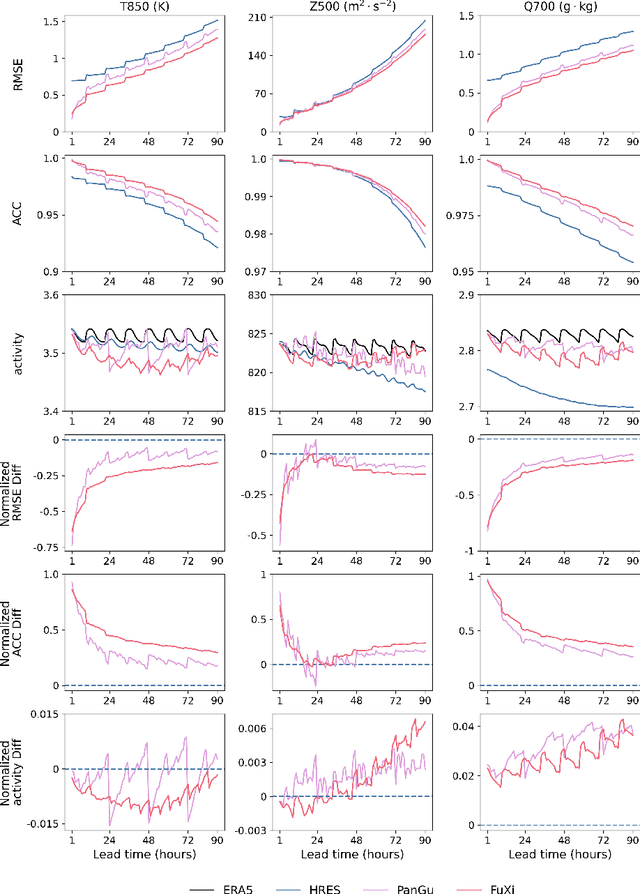
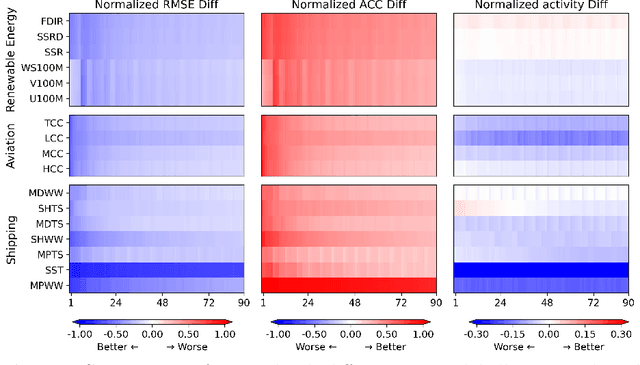
Abstract:Machine learning (ML) models have become increasingly valuable in weather forecasting, providing forecasts that not only lower computational costs but often match or exceed the accuracy of traditional numerical weather prediction (NWP) models. Despite their potential, ML models typically suffer from limitations such as coarse temporal resolution, typically 6 hours, and a limited set of meteorological variables, limiting their practical applicability. To overcome these challenges, we introduce FuXi-2.0, an advanced ML model that delivers 1-hourly global weather forecasts and includes a comprehensive set of essential meteorological variables, thereby expanding its utility across various sectors like wind and solar energy, aviation, and marine shipping. Our study conducts comparative analyses between ML-based 1-hourly forecasts and those from the high-resolution forecast (HRES) of the European Centre for Medium-Range Weather Forecasts (ECMWF) for various practical scenarios. The results demonstrate that FuXi-2.0 consistently outperforms ECMWF HRES in forecasting key meteorological variables relevant to these sectors. In particular, FuXi-2.0 shows superior performance in wind power forecasting compared to ECMWF HRES, further validating its efficacy as a reliable tool for scenarios demanding precise weather forecasts. Additionally, FuXi-2.0 also integrates both atmospheric and oceanic components, representing a significant step forward in the development of coupled atmospheric-ocean models. Further comparative analyses reveal that FuXi-2.0 provides more accurate forecasts of tropical cyclone intensity than its predecessor, FuXi-1.0, suggesting that there are benefits of an atmosphere-ocean coupled model over atmosphere-only models.
FuXi Weather: An end-to-end machine learning weather data assimilation and forecasting system
Aug 10, 2024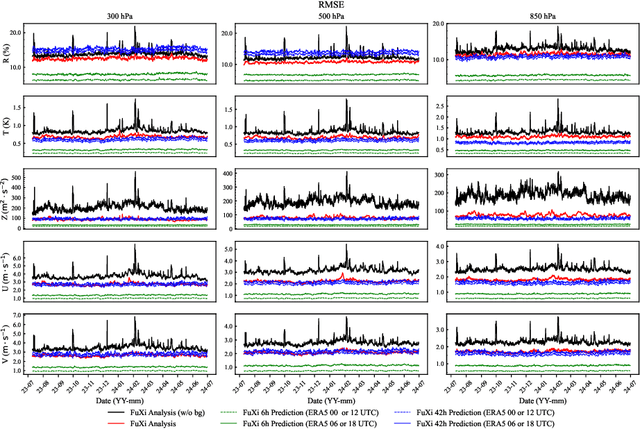
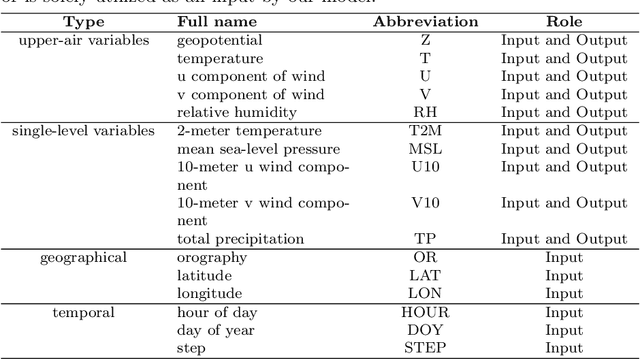
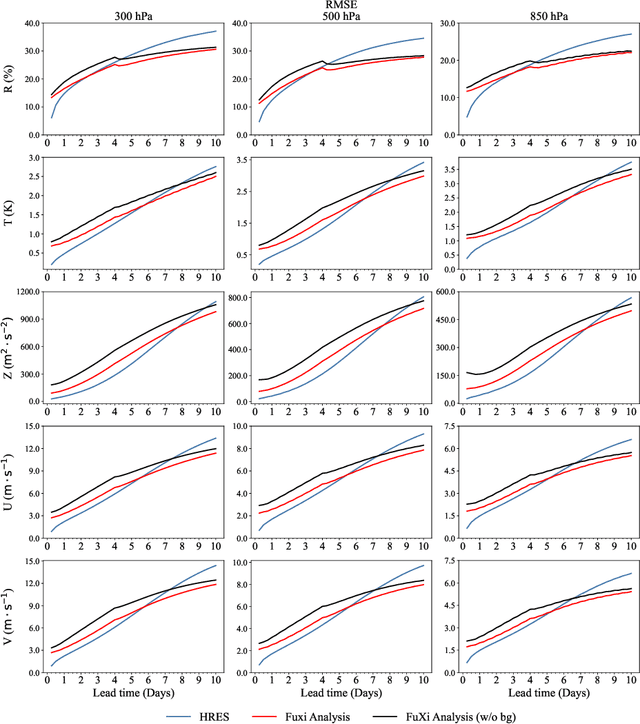

Abstract:Operational numerical weather prediction systems consist of three fundamental components: the global observing system for data collection, data assimilation for generating initial conditions, and the forecasting model to predict future weather conditions. While NWP have undergone a quiet revolution, with forecast skills progressively improving over the past few decades, their advancement has slowed due to challenges such as high computational costs and the complexities associated with assimilating an increasing volume of observational data and managing finer spatial grids. Advances in machine learning offer an alternative path towards more efficient and accurate weather forecasts. The rise of machine learning based weather forecasting models has also spurred the development of machine learning based DA models or even purely machine learning based weather forecasting systems. This paper introduces FuXi Weather, an end-to-end machine learning based weather forecasting system. FuXi Weather employs specialized data preprocessing and multi-modal data fusion techniques to integrate information from diverse sources under all-sky conditions, including microwave sounders from 3 polar-orbiting satellites and radio occultation data from Global Navigation Satellite System. Operating on a 6-hourly DA and forecasting cycle, FuXi Weather independently generates robust and accurate 10-day global weather forecasts at a spatial resolution of 0.25\textdegree. It surpasses the European Centre for Medium-range Weather Forecasts high-resolution forecasts in terms of predictability, extending the skillful forecast lead times for several key weather variables such as the geopotential height at 500 hPa from 9.25 days to 9.5 days. The system's high computational efficiency and robust performance, even with limited observations, demonstrates its potential as a promising alternative to traditional NWP systems.
FuXi-ENS: A machine learning model for medium-range ensemble weather forecasting
May 09, 2024



Abstract:Ensemble weather forecasting is essential for weather predictions and mitigating the impacts of extreme weather events. Constructing an ensemble prediction system (EPS) based on conventional numerical weather prediction (NWP) models is highly computationally expensive. Machine learning (ML) models have emerged as valuable tools for deterministic weather forecasts, providing forecasts with significantly reduced computational requirements and even surpassing the forecast performance of traditional NWP models. However, challenges arise when applying ML models to ensemble forecasting. Recent ML models, such as GenCast and SEEDS model, rely on the ERA5 Ensemble of Data Assimilations (EDA) or two operational NWP ensemble members for forecast generation. The spatial resolution of 1{\deg} or 2{\deg} in these models is often considered too coarse for many applications. To overcome these limitations, we introduce FuXi-ENS, an advanced ML model designed to deliver 6-hourly global ensemble weather forecasts up to 15 days. This model runs at a significantly improved spatial resolution of 0.25{\deg}, incorporating 5 upper-air atmospheric variables at 13 pressure levels, along with 13 surface variables. By leveraging the inherent probabilistic nature of Variational AutoEncoder (VAE), FuXi-ENS optimizes a loss function that combines the continuous ranked probability score (CRPS) and the KL divergence between the predicted and target distribution. This innovative approach represents an advancement over the traditional use of L1 loss combined with the KL loss in standard VAE models when VAE for ensemble weather forecasts. Evaluation results demonstrate that FuXi-ENS outperforms ensemble forecasts from the European Centre for Medium-Range Weather Forecasts (ECMWF), a world leading NWP model, on 98.1% of 360 variable and forecast lead time combinations on CRPS.
Fuxi-DA: A Generalized Deep Learning Data Assimilation Framework for Assimilating Satellite Observations
Apr 12, 2024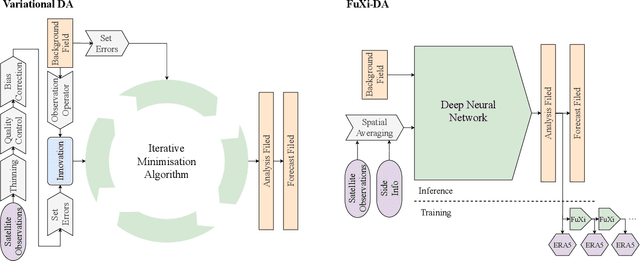



Abstract:Data assimilation (DA), as an indispensable component within contemporary Numerical Weather Prediction (NWP) systems, plays a crucial role in generating the analysis that significantly impacts forecast performance. Nevertheless, the development of an efficient DA system poses significant challenges, particularly in establishing intricate relationships between the background data and the vast amount of multi-source observation data within limited time windows in operational settings. To address these challenges, researchers design complex pre-processing methods for each observation type, leveraging approximate modeling and the power of super-computing clusters to expedite solutions. The emergence of deep learning (DL) models has been a game-changer, offering unified multi-modal modeling, enhanced nonlinear representation capabilities, and superior parallelization. These advantages have spurred efforts to integrate DL models into various domains of weather modeling. Remarkably, DL models have shown promise in matching, even surpassing, the forecast accuracy of leading operational NWP models worldwide. This success motivates the exploration of DL-based DA frameworks tailored for weather forecasting models. In this study, we introduces FuxiDA, a generalized DL-based DA framework for assimilating satellite observations. By assimilating data from Advanced Geosynchronous Radiation Imager (AGRI) aboard Fengyun-4B, FuXi-DA consistently mitigates analysis errors and significantly improves forecast performance. Furthermore, through a series of single-observation experiments, Fuxi-DA has been validated against established atmospheric physics, demonstrating its consistency and reliability.
Is Artificial Intelligence Providing the Second Revolution for Weather Forecasting?
Jan 30, 2024Abstract:The rapid advancement of artificial intelligence technologies, particularly in recent years, has led to the emergence of several large parameter artificial intelligence weather forecast models. These models represent a significant breakthrough, overcoming the limitations of traditional numerical weather prediction models and indicating a potential second revolution for weather forecast. This study explores the evolution of these advanced artificial intelligence forecast models, and based on the identified commonalities, proposes the "Three Large Rules" for their development. We discuss the potential of artificial intelligence in revolutionizing numerical weather prediction, briefly outlining the underlying reasons for this potential. Additionally, we explore key areas for future development prospects for large artificial intelligence weather forecast models, integrating the entire numerical prediction process. Through an example that combines a large artificial intelligence model with ocean wave forecasting, we illustrate how forecasters can adapt and leverage the advanced artificial intelligence model. While acknowledging the high accuracy, computational efficiency, and ease of deployment of large artificial intelligence forecast models, we emphasize the irreplaceable values of traditional numerical forecasts. We believe that the optimal future of weather forecasting lies in achieving a seamless integration of artificial intelligence and traditional numerical models. Such a synthesis is anticipated to offer a more comprehensive and reliable approach for future weather forecasting.
FuXi-S2S: An accurate machine learning model for global subseasonal forecasts
Dec 15, 2023Abstract:Skillful subseasonal forecasts beyond 2 weeks are crucial for a wide range of applications across various sectors of society. Recently, state-of-the-art machine learning based weather forecasting models have made significant advancements, outperforming the high-resolution forecast (HRES) from the European Centre for Medium-Range Weather Forecasts (ECMWF). However, the full potential of machine learning models in subseasonal forecasts has yet to be fully explored. In this study, we introduce FuXi Subseasonal-to-Seasonal (FuXi-S2S), a machine learning based subseasonal forecasting model that provides global daily mean forecasts up to 42 days, covering 5 upper-air atmospheric variables at 13 pressure levels and 11 surface variables. FuXi-S2S integrates an enhanced FuXi base model with a perturbation module for flow-dependent perturbations in hidden features, and incorporates Perlin noise to perturb initial conditions. The model is developed using 72 years of daily statistics from ECMWF ERA5 reanalysis data. When compared to the ECMWF Subseasonal-to-Seasonal (S2S) reforecasts, the FuXi-S2S forecasts demonstrate superior deterministic and ensemble forecasts for total precipitation (TP), outgoing longwave radiation (OLR), and geopotential at 500 hPa (Z500). Although it shows slightly inferior performance in predicting 2-meter temperature (T2M), it has clear advantages over land area. Regarding the extreme forecasts, FuXi-S2S outperforms ECMWF S2S globally for TP. Furthermore, FuXi-S2S forecasts surpass the ECMWF S2S reforecasts in predicting the Madden Julian Oscillation (MJO), a key source of subseasonal predictability. They extend the skillful prediction of MJO from 30 days to 36 days.
Machine Learning Parameterization of the Multi-scale Kain-Fritsch (MSKF) Convection Scheme
Nov 07, 2023



Abstract:Warm-sector heavy rainfall often occurs along the coast of South China, and it is usually localized and long-lasting, making it challenging to predict. High-resolution numerical weather prediction (NWP) models are increasingly used to better resolve topographic features and forecast such high-impact weather events. However, when the grid spacing becomes comparable to the length scales of convection, known as the gray zone, the turbulent eddies in the atmospheric boundary layer are only partially resolved and parameterized to some extent. Whether using a convection parameterization (CP) scheme in the gray zone remains controversial. Scale-aware CP schemes are developed to enhance the representation of convective transport within the gray zone. The multi-scale Kain-Fritsch (MSKF) scheme includes modifications that allow for its effective implementation at a grid resolution as high as 2 km. In recent years, there has been an increasing application of machine learning (ML) models to various domains of atmospheric sciences, including the replacement of physical parameterizations with ML models. This work proposes a multi-output bidirectional long short-term memory (Bi-LSTM) model as a replace the scale-aware MSKF CP scheme. The Weather Research and Forecast (WRF) model is used to generate training and testing data over South China at a horizontal resolution of 5 km. Furthermore, the WRF model is coupled with the ML based CP scheme and compared with WRF simulations with original MSKF scheme. The results demonstrate that the Bi-LSTM model can achieve high accuracy, indicating the potential use of ML models to substitute the MSKF scheme in the gray zone.
 Add to Chrome
Add to Chrome Add to Firefox
Add to Firefox Add to Edge
Add to Edge